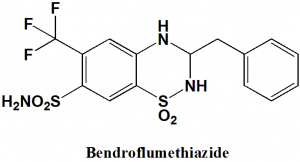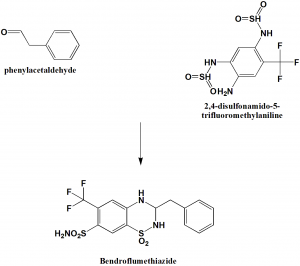BENDROFLUMETHIAZIDE Synthesis, SAR, MCQ,Structure,Chemical Properties and Therapeutic Uses
Bendroflumethiazide
IUPAC nomenclature
3-Benzyl-1,1-dioxo-6-(trifluoromethyl)-3,4-dihydro-2H-1,2,4- benzothiadiazine-7-sulfonamide
Classification
- Thiazide diuretic
Physiochemical Properties
| S. NO. | PHYSICAL AND CHEMICAL PROPERTIES | |
| 1 | Molecular weight | 421.4 g/mol |
| 2 | Physical appearance | White to cream-colored crystalline powder. |
| 3 | Melting point | 222-223oC |
| 4 | Solubility | Freely soluble in acetone and alcohol |
| 5 | Octanol/water partition coefficient | 1.89 |
| 5 | Presence of ring | Benzothiazine |
| 6 | Number of chiral centers | 1 |
Mechanism of Action
- Bendroflumethiazide prevents active chloride reabsorption at the early distal tubule through the sodium chloride contransportor which results in an increase in the excretion of sodium, chloride and water from the body.
- The drug also binds with thiazide-sensitive Na-Cl transportor and prevents sodium ion ranspprt across the renal tubular epithelium. This increases the potassium excretion through Na-K exchange mechanism.
- It can also mediate its actions on carbonic anhydrase in the smooth muscle or on the large-conductance KCa channel found in smooth muscle.
Structure Activity Relationship
General structure activity of thiazide diuretics can be summarized as:
- Chlorothiazide is the simplest member of the series.
- Hydrogen atom at the 2-N is most acidic due to presence of electron-withdrawing group.
- Sulfonamide group at C-7 position provides additional acidity to the drug.
- Electron withdrawing group is essential at position 6 for diuretic activity of the drug.
- Substitution on hydrogen at 6 position gives little diuretic activity, whereas, substitution with chloro and trifluoromethyl groups gives highly active compounds.
- Substitution of electron donating group at position 6 significantly reduces the diuretic activity.
- Replacement or removal of sulfonamide groups from position 7 significantly reduces the diuretic activity.
- Saturation of the double bond to give 2,4-dihydro derivative are 10-folds more active than the unsaturated compounds.
- Substitution of a lipophillic group at 3 position increases the potency.
- Substitution with the entities such as haloalkyl, aralkyl or thioether gives compounds with longer duration of action due to increased lipid solubility.
- Alkyl substitution at the 2-N position can increase the action duration. [1]
Method of synthesis
Bendroflumethiazide can be synthesized by the reaction between phenylacetaldehyde and 2,4-disulfonamido-5-trifluoromethylaniline. [2]
Medicinal Uses
Bendroflumethiazide is used for:
- Treatment of high blood pressure
- Management of edema related to heart failure
Side Effects
Side effects of bendroflumethiazide are:
- Dizziness
- Low amount of sodium and potassium in blood
- Low blood pressure
- Nausea
- Vomiting
- Decreased appetite
- Diarrhea
- Dry mouth
- Stuffy nose
MCQs
Q.1 Bendroflumethiazide prevents?
a) Passive Chloride reabsorption at the early distal tubule
b) Active Chloride reabsorption at the early distal tubule
c) Passive Chloride reabsorption at the PCT
d) Active Chloride reabsorption at the PCT
Q.2 Therapeutic use of drug Bendroflumethiazide is/are?
a) Treatment of angina pectoris
b) Treatment of Hypertension
c) Treatment of syncope
d) All of the above
Q.3 Most acidic group on thiazide diuretics compounds is?
a) Hydrogen at 2-N position
b) Sulfonamide at C-7 position
c) Hydrogen at 6th position
d) None of the above
Q.4 Bendroflumethiazide can be produces by reaction of phenylacetaldehyde with?
a) 2,4-disulfonamido-5-trifluoromethylaniline
b) 3,5-disulfonamido-5-trifluoromethylaniline
c) Propanone
d) Phenol
Q.5 Correct sequence for the True/False for the physiochemical properties of the drug bendroflumethiazide can be?
I. Molecular weight = 875.3 gm/mol
II. Physical appearance = Colorless to yellowish liquid
III. Melting point = 222.5 oC
a) TFT
b) FFT
c) FFF
d) TTT
Q.6 Correct statements for the IUPAC nomenclatures of the drug are?
I. Bendroflumethiazide: (3-methylbutyl) nitrite
II. Mefenemic acid: 2-{[3-(Trifluoromethyl)phenyl]amino}benzoic acid
III. Ketorolac: (±)-5-benzoyl-2,3-dihydro-1H-pyrrolizine-1-carboxylic acid
IV. Flubiprofen: (RS)-2-(2-fluorobiphenyl-4-yl)propanoic acid
a) I, II, III, IV
b) III, IV
c) II, III, IV
d) I, II
Q.7 Match the following drugs with their correct classifications-
| i. Nitroglycerine | A. Antianginal drug |
| ii. Tripelenamine | B. Diuretics |
| iii. Bendroflumethiazide | C. Alkylating agent |
| iv. Thiotepa | D. H1-antagonist |
a) i-A, ii-C, iii-D, iv-B
b) i-A, ii-D, iii-B, iv-C
c) i-D, ii-B, iii-A, iv-C
d) i-D, ii-A, iii-C, iv-B
Participate in Online FREE GPAT TEST: CLICK HERE
Participate in Online FREE Pharmacist TEST: CLICK HERE
Participate in Online FREE Drug Inspector TEST: CLICK HERE
Participate in CSIR NET JRF Mock Test
ANSWERS
1-b
2-b
3-a
4-a
5-b
6-b
7-b
REFERENCES
[1] Lemke TL, Williams DA, editors. Foye’s principles of medicinal chemistry. Lippincott Williams & Wilkins; 2012 Jan 24. [2] Vardanyan R, Hruby V. Synthesis of essential drugs. Elsevier; 2006 Mar 10.

